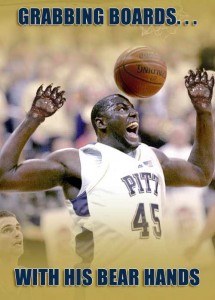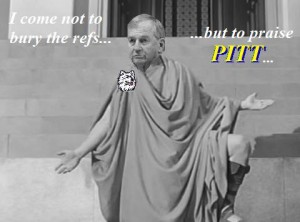Just a bunch of Big East stuff, some not directly related to Pitt basketball that are worth linking.
This SI.com feature on following Syracuse for a spell to show how brutal life in the Big East has become, is excellent. What ends up jumping out at you though, is getting a picture of a beaten down Paul Harris.
But now it was three o’clock last Saturday afternoon, and a 98-94 overtime win over Georgetown before 32,000 orange-wearing loyalists at the Carrier Dome was a few minutes old, and Harris was smiling. Sort of. “To be honest with you, having Coach Boeheim on me all the time is hard,” said Harris, whose full-court inbounds pass to junior guard Eric Devendorf all but sealed the game with 18 seconds left in OT after the Orange had blown a 16-point lead in the final eight minutes of regulation. “It doesn’t do any good debating with him, because you can’t win. He gets me thinking too much about mistakes.” Harris paused. “But I’m going to keep going because that’s what you gotta do. This is the Big East, right?”
Copy that, as Jack Bauer says. The victory stopped an unnerving Syracuse skid — six losses in the previous eight games, all to Big East opponents — that showed how hard it is for a good but not great team to gain traction in a conference that offers precious few soft touches. Just ask Georgetown, the only team to have beaten UConn this season. The Hoyas, who were once ranked as high as ninth in the country, were in 12th place in the Big East at week’s end. Playing the nation’s second-toughest schedule, they had lost eight of their last 11 conference games and, at 13-10 overall, will probably need to win at least five of their last six to get an NCAA bid. Georgetown is spinning in what Connecticut coach Jim Calhoun calls “the washer, a cycle of losing with seemingly no way out.”
Over the last three weeks Notre Dame has gotten Maytagged too. Ranked as high as seventh six weeks ago, the Irish (11th- most-difficult schedule) lost six league games in a row, and chances are that its surprising 90-57 rout of then fifth-ranked Louisville last Thursday will not persuade the NCAA selection committee to award the Irish a tournament berth.
“Our bottom teams would be middle to top tier anywhere else in the country, including the ACC,” says Pitt point guard Levance Fields, whose Panthers are ranked fourth behind UConn, Oklahoma and North Carolina in the latest AP poll. “Quality teams like Georgetown and Notre Dame are struggling because of how tough the league is.”
When you stop and think about it — whether with or without sympathy — this season has to have been brutal for players like Kyle McAlarney, Luke Harangody, Jesse Sapp, DaJuan Summers and Paul Harris. Really good players with expectations and seemingly not able to catch their breath.
Continuing the brutal Big East theme, on the Big East Coaches call this week, Jim Calhoun railed against the 18 game conference schedule.
The big news on today’s Big East conference call was that UConn coach Jim Calhoun said the 18-game Big East schedule was unnecessary and could prevent a couple of teams from making the NCAA Tournament. Calhoun, whose team is 24-2 and could get a No. 1 seed in the Big Dance, said the league should return to a 16-game slate.
“I really like the Providence team and I’m sure they’re on the bubble [because of the scheduling],” Calhoun said. “Providence is the third team after Notre Dame and Georgetown who I believe is NCAA quality.”
ESPN bracketologist Joe Lunardi recently said that the first four teams out of the NCAA Tournament included Georgetown, Providence and Cincinnati.
Several of Calhoun’s colleagues, including Rick Pitino of Louisville and Freddie Hill of Rutgers, concurred that a 16-game slate would be preferred.
Rick Pitino took a shot at Memphis in the process.
“I think if you were in Conference USA 18 games would be fine. I’m sure that Memphis enjoys that…But in the Big East 18 games is overpowering. I think every coach would agree with Jim [Calhoun]. They signed a contract with ESPN to play 18 games. It’s all money-driven. It is very difficult on the players and the coaches, all we are is beating up each other.”
One of the other reason for the 18 game schedule is to also to put less pressure on filling out the non-con schedule. Something that teams were struggling a bit as a lot of mid-majors were demanding return games rather than taking the guarantee.
Given the recession and increasing impact on athletic department budgets, I don’t see things changing. Speaking of cheap athletic departments, Seton Hall was actually going to skimp on sending their pep band and cheerleaders to the Big East Tournament. Apparently they felt the cost of chartering a couple buses to take the kids 18 miles was just not worth the money. At least until the negative publicity started.
Dick Weiss has a piece on the Big East being having the most elite, Final Four potential teams in years.
“I personally believe there are four, five, six teams in our league that could make the Final Four,” Calhoun said.
In most years, that might be wishful thinking.
But the Big East this year has been a beast. Maybe not as good as 1985, when Villanova won the national championship and the league put three teams in the Final Four. Maybe not as deep as some coaches – who feel the league deserves nine, even 10 NCAA Tournament bids – believe.
The ACC actually has a higher RPI conference ranking and might even produce more NCAA teams when the dust settles. The Big East, which got eight bids last year, could be limited to seven this time because teams such as Notre Dame and Georgetown – which were both ranked in the AP Top 10 earlier this season – and senior-dominated Providence are in the midst of being devoured in this carnivorous league. All three and surprising Cincinnati could still sneak into the NCAAs, but they could also be playing in first-round games in the expanded Big East Tournament.
This league is that unforgiving.
Having said that, this monstrous 16-team conference has so much quality at the top, the seven best teams – Pitt, UConn, Louisville, Villanova, West Virginia, Marquette and Syracuse – could all wind up with top-six seeds when the NCAA Tournament bids are announced March15. All seven are ranked in the Top 25 by the RPI and Sagarin ratings.
“Ultimately, you’re judged by what you do in postseason,” Big East commissioner Mike Tranghese said. “But I clearly think, between Pitt, UConn and Louisville, we could have two No.1s and a No.2.”
Keeping that eye on Arizona for smoke signals on their plan for hiring a coach. The AD there has admitted that while he hasn’t hired a “search consultant” to put out feelers, he has put an intermediary to work.
Q. Where are you at in the hiring process?
“I’ve looked at a lot of people across the country and obviously I won’t be throwing out any names. I’ve had an intermediary talk to and visit with a number of people.
“I’m not down to a final pool, but we’ve got it down to a group of people where they would be a fit for us. As generic as that sounds as of (now), that’s the only place we can be . . . because most of them are coaching.”
…
Q. Are you using a third party to reach out to candidates?
“I’m going through C.M. Newton (former Kentucky athletic director). C.M. has been helpful on a number of fronts. There are a lot of people who want to help. But at this point, the confidentiality is much better with the fewest number of people involved. I trust him. He’s been a member of basketball organizations at a number of different levels. When he leaves a message for somebody, they’ll call back.”
Q. Is your biggest fear having the news be leaked out?
“It’s my only fear. . . . having somebody exposed who would have been a great fit. The best coaches out there can’t afford to have their name linked to this. They can’t afford it in their own community because they are not in good jobs but in great jobs and are being successful.”
We’ll see.





